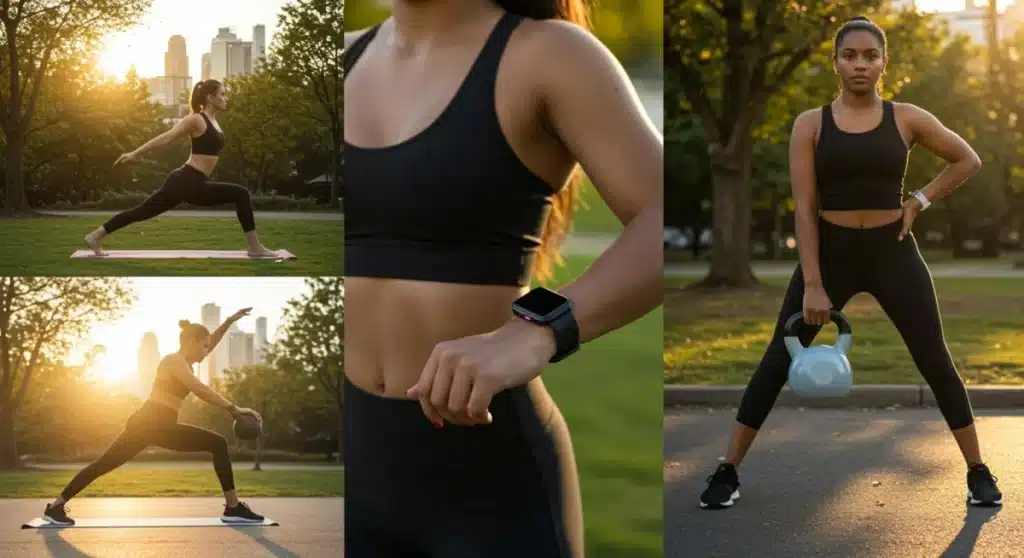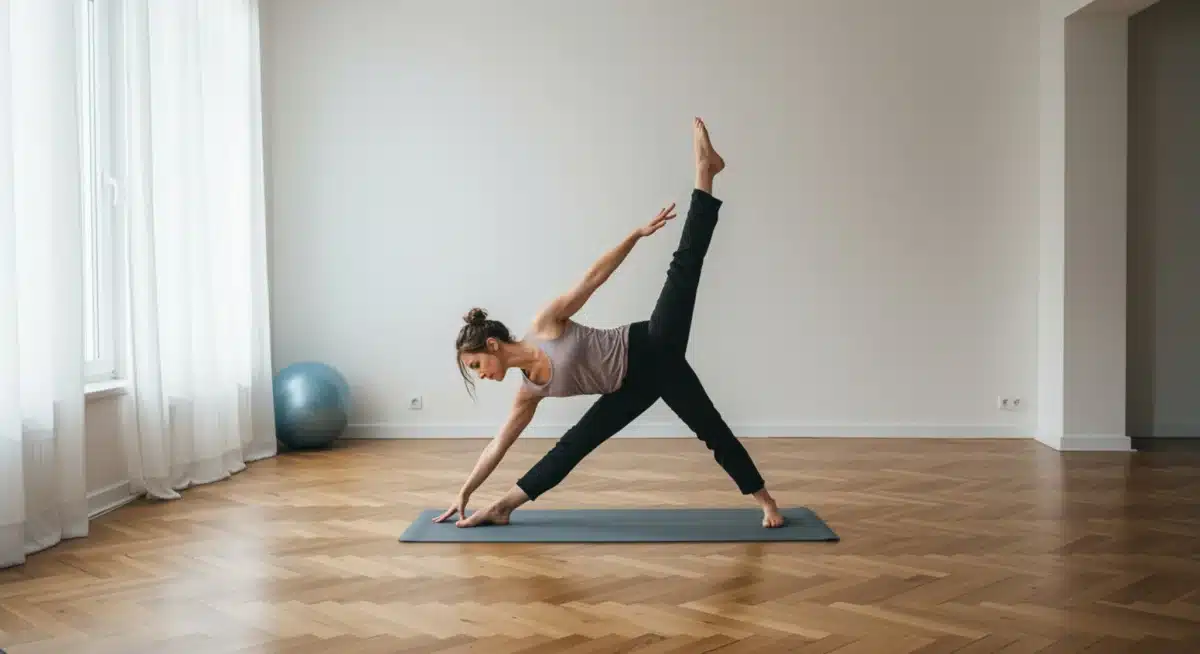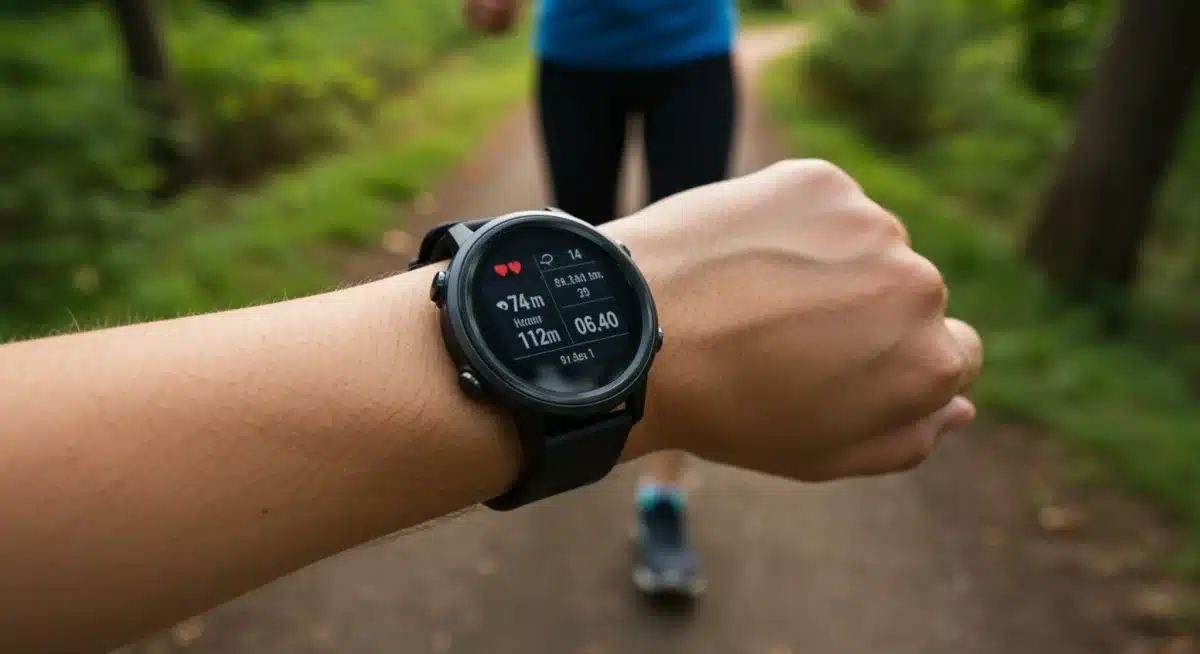Maximize Your Wellness: Top 5 Fitness Trends in the US This Year

The US fitness scene this year is dominated by five transformative trends: mindful movement, advanced tech integration, outdoor fitness, personalized nutrition, and functional training, each contributing to a more holistic and accessible approach to maximizing wellness.
Are you ready to discover how to maximize your wellness: 5 new fitness trends gaining popularity in the US this year? From innovative workout routines to a more holistic approach to health, the fitness landscape in the United States is continuously evolving, offering exciting new ways to stay active and feel great. This article will delve into the cutting-edge trends shaping how Americans approach their health and fitness journeys in 2025 and beyond.
The Rise of Mindful Movement: Beyond Just Exercise
The concept of mindful movement is rapidly transforming how individuals perceive and engage with physical activity. It’s a shift from purely performance-driven workouts to practices that integrate mental and emotional well-being with physical exertion. This trend emphasizes listening to one’s body, reducing stress, and fostering a deeper connection between mind and body, making fitness a more sustainable and enjoyable part of daily life.
This holistic approach contrasts sharply with traditional high-intensity workouts that often prioritize calorie burning and muscle gain above all else. Mindful movement encourages slower, more deliberate motions, allowing for greater awareness of posture, breath, and sensation. It’s about quality over quantity, ensuring each movement serves a purpose beyond just physical output.
Pilates and Yoga Reimagined
While Pilates and yoga have long been cornerstones of mindful movement, their popularity is surging with new variations and accessibility. Studios are offering classes that blend traditional techniques with contemporary approaches, making them appealing to a broader audience. The focus remains on core strength, flexibility, and mental clarity, but with innovative twists.
- Reformer Pilates Expansion: More studios are investing in reformer machines, offering dynamic, full-body workouts that are low-impact yet highly effective for muscle toning and alignment.
- Aerial Yoga: Utilizing hammocks to support the body, aerial yoga allows for deeper stretches and inversions, promoting decompression of the spine and enhancing flexibility with a playful element.
- Mindful Vinyasa Flows: These classes emphasize fluid transitions synchronized with breath, encouraging participants to stay present and connected to their bodies throughout the practice.
- Yoga Nidra for Stress Reduction: Often called ‘yogic sleep,’ this guided meditation practice is gaining traction for its profound ability to induce deep relaxation and alleviate chronic stress.
The beauty of these practices lies in their adaptability. They cater to all fitness levels, from beginners to seasoned athletes, providing benefits that extend beyond the physical realm into mental resilience and emotional balance. Many practitioners report improved sleep, reduced anxiety, and a greater sense of overall calm.
Incorporating Breathwork and Meditation
Integral to mindful movement is the deliberate incorporation of breathwork (pranayama) and meditation. These practices are no longer confined to spiritual retreats but are becoming mainstream components of fitness routines. Instructors are increasingly guiding participants through breathing exercises to enhance focus, improve oxygen uptake, and manage stress before, during, and after physical activity.
Meditation, even in short bursts, can significantly impact one’s ability to stay present during a workout and improve recovery. Apps and online platforms are making these practices more accessible, allowing individuals to integrate them into their daily lives without needing to attend specialized classes. This fusion of physical and mental training is creating a more rounded and sustainable approach to fitness.
Ultimately, the rise of mindful movement signifies a broader cultural shift towards prioritizing holistic well-being. It’s about cultivating a healthier relationship with one’s body and mind, recognizing that true fitness encompasses more than just physical appearance or strength. This trend encourages a journey of self-discovery and sustainable health practices.
Tech-Integrated Workouts: Smart Fitness for Smarter Results
Technology continues to revolutionize the fitness industry, making workouts more personalized, efficient, and engaging than ever before. Tech-integrated workouts leverage advanced devices, applications, and platforms to provide real-time feedback, customized training plans, and immersive experiences. This trend appeals to those seeking data-driven insights and convenient ways to track their progress and optimize their health routines.
From wearable devices that monitor vital statistics to smart gym equipment that adapts to your performance, technology is transforming passive exercise into an active, informed experience. This integration helps individuals understand their bodies better, set realistic goals, and stay motivated through tangible progress measurements.
Wearable Technology at the Forefront
Wearable technology remains a dominant force in fitness, with smartwatches, fitness trackers, and even smart rings offering increasingly sophisticated features. These devices go beyond step counting, providing detailed analytics on heart rate variability, sleep patterns, stress levels, and recovery metrics. This wealth of data empowers users to make informed decisions about their activity levels and overall well-being.
- Advanced Health Monitoring: New generations of wearables offer ECG capabilities, blood oxygen tracking, and even skin temperature monitoring, providing a comprehensive view of one’s health status.
- Personalized Coaching: Many devices now integrate AI-powered coaching that analyzes your data to suggest personalized workouts, recovery periods, and nutritional advice.
- Seamless Integration: Wearables often sync with other fitness apps and platforms, creating a unified ecosystem for tracking all aspects of health and fitness.
- Enhanced Motivation: Gamification features, challenges, and social sharing options embedded in wearable tech foster a sense of community and friendly competition, keeping users motivated.
The continuous innovation in wearable technology ensures that these devices are not just gadgets but essential tools for anyone serious about optimizing their health. They provide an unprecedented level of insight into personal physiology, allowing for truly individualized wellness strategies.

Virtual and Augmented Reality Fitness
Virtual Reality (VR) and Augmented Reality (AR) are no longer just for gaming; they are carving out a significant niche in the fitness world. These technologies offer immersive workout experiences that can transport users to exotic locations, engage them in interactive games, or provide personalized coaching in a virtual environment. This adds an element of fun and novelty, combating workout monotony.
VR fitness platforms allow users to cycle through virtual landscapes, battle enemies in fitness-based games, or participate in group classes from the comfort of their homes. AR apps, on the other hand, can overlay digital information onto the real world, providing guidance during outdoor runs or interactive elements during home workouts. These technologies make exercise more accessible and enjoyable for many.
The appeal of tech-integrated workouts lies in their ability to provide convenience, customization, and continuous feedback. They democratize access to high-quality fitness resources, allowing individuals to train effectively regardless of their location or schedule. This trend is set to grow even further as technology becomes more sophisticated and affordable, making smart fitness a staple for achieving smarter results.
Embracing the Outdoors: Nature as Your Gym
After periods of indoor confinement and increased screen time, there’s a growing yearning for fresh air and natural environments. This has fueled a significant trend: embracing the outdoors as a primary fitness space. People are rediscovering the joy and benefits of exercising amidst nature, moving away from traditional gym settings to parks, trails, and open bodies of water. This shift is driven by a desire for mental rejuvenation as much as physical activity.
Exercising outdoors offers a unique blend of physical challenge and psychological uplift. The varied terrain, natural obstacles, and changing weather conditions provide a dynamic workout that engages more muscle groups than a sterile gym environment. Moreover, exposure to nature has been scientifically linked to reduced stress, improved mood, and enhanced cognitive function.
Hiking and Trail Running Boom
Hiking and trail running have seen an explosion in popularity, with more Americans exploring national parks, state forests, and local green spaces. These activities offer a fantastic cardiovascular workout while immersing participants in scenic beauty. The uneven surfaces of trails also improve balance, agility, and strengthen stabilizer muscles, which are often neglected in indoor workouts.
- Accessible Trails: Many communities are investing in developing and maintaining diverse trail networks, making it easier for people of all fitness levels to participate.
- Group Events: Organized hiking and trail running groups provide a social aspect, encouraging camaraderie and motivation among participants.
- Mental Health Benefits: Spending time in nature, often referred to as ‘forest bathing,’ is proven to reduce cortisol levels, lower blood pressure, and improve overall mental clarity.
- Year-Round Appeal: With appropriate gear, hiking and trail running can be enjoyed in various seasons, offering a continuous connection to the outdoors.
The simplicity and accessibility of these activities make them appealing to a broad demographic, from casual walkers to seasoned ultra-marathoners. They provide a much-needed escape from daily routines and an opportunity to reconnect with the natural world.
Open Water Swimming and Paddle Sports
For those seeking a low-impact yet highly effective full-body workout, open water swimming and paddle sports are gaining immense traction. Lakes, rivers, and oceans are becoming popular venues for activities like swimming, kayaking, stand-up paddleboarding (SUP), and even surf-skiing. These sports offer a refreshing alternative to pool swimming or land-based exercises.
Open water swimming challenges individuals with variable conditions, including currents and waves, enhancing strength and endurance. Paddle sports, particularly SUP, engage core muscles, improve balance, and provide an excellent upper-body workout. The serene environment of natural waters also contributes to a sense of peace and relaxation, making these activities both physically and mentally rewarding.
The trend of embracing the outdoors for fitness is more than just a passing fad; it represents a fundamental shift towards a more balanced and environmentally conscious approach to wellness. It highlights the understanding that physical health is deeply intertwined with our surroundings and the quality of our natural engagement. This movement encourages us to step outside and let nature be our most inspiring gym.
Personalized Nutrition: Fueling Your Body Uniquely
The one-size-fits-all approach to diet and nutrition is rapidly becoming obsolete. Personalized nutrition, tailored to an individual’s unique genetic makeup, lifestyle, and health goals, is emerging as a cornerstone of modern wellness. This trend leverages scientific advancements and data analytics to provide highly specific dietary recommendations, moving beyond generic caloric intake or macronutrient ratios.
Understanding that every body responds differently to food, personalized nutrition aims to optimize health outcomes, enhance athletic performance, and prevent chronic diseases by aligning dietary choices with individual biological needs. This bespoke approach empowers individuals to take control of their health in a more precise and effective manner.
Genetic and Microbiome Testing
At the forefront of personalized nutrition are genetic (nutrigenomic) and microbiome testing. These advanced analyses provide invaluable insights into how an individual’s genes affect nutrient metabolism, food sensitivities, and disease predispositions, as well as the composition and function of their gut bacteria. This information forms the basis for highly customized dietary plans.
- Nutrigenomics: By analyzing specific gene variations, practitioners can recommend optimal ratios of macronutrients, identify potential vitamin deficiencies, and advise on foods that best support an individual’s genetic profile.
- Microbiome Analysis: Understanding the diversity and balance of gut bacteria can inform dietary choices that promote a healthy gut, impacting everything from digestion and immunity to mood and weight management.
- Personalized Supplementation: Based on test results, specific vitamin, mineral, and probiotic supplements can be recommended to address individual deficiencies or support particular health goals.
- Targeted Meal Planning: Nutritionists and dietitians use this data to create meal plans that are not only delicious but also scientifically optimized for the individual, taking into account allergies, intolerances, and preferences.
These sophisticated tests move beyond guesswork, offering actionable data that can profoundly impact an individual’s health trajectory. They represent a paradigm shift in how we approach diet, making it a truly scientific endeavor.
AI-Powered Dietary Coaching and Apps
The integration of Artificial Intelligence (AI) into nutrition coaching is making personalized dietary advice more accessible and dynamic. AI-powered apps and platforms can analyze vast amounts of data, including genetic information, activity levels, food logs, and even wearable data, to provide real-time, adaptive dietary recommendations.

These intelligent systems can adjust meal plans based on daily activity, provide personalized recipe suggestions, and even predict how certain foods might affect an individual’s energy levels or blood sugar. This level of responsiveness ensures that nutrition advice remains relevant and effective as an individual’s needs evolve.
Personalized nutrition is about empowering individuals with the knowledge and tools to make optimal food choices for their unique bodies. It’s a journey of discovery, moving towards a future where diet is not just about eating healthy, but about eating intelligently and specifically for oneself, thereby truly fueling the body uniquely and maximizing overall wellness.
Functional Training: Fitness for Everyday Life
Functional training is experiencing a resurgence, moving from niche athletic circles to mainstream fitness. This approach focuses on exercises that mimic real-life movements, preparing the body for daily activities rather than isolating specific muscles. It emphasizes multi-joint, multi-planar movements that improve strength, balance, coordination, and mobility, making everyday tasks easier and reducing the risk of injury.
Unlike bodybuilding or purely aesthetic training, functional training prioritizes utility and practicality. It’s about building a body that performs well in the real world, whether that means lifting groceries, playing with children, or performing demanding occupational tasks. This practicality makes it highly appealing to a broad demographic, from desk workers to seasoned athletes.
Bodyweight and Kettlebell Workouts
Bodyweight exercises and kettlebell training are at the core of functional fitness. Bodyweight exercises, such as squats, lunges, push-ups, and planks, use your own body’s resistance to build strength and endurance without needing any equipment. They are highly adaptable and can be performed anywhere, making them incredibly accessible.
- Kettlebell Versatility: Kettlebells are ideal for dynamic, full-body movements like swings, cleans, and snatches, which improve power, cardiovascular fitness, and grip strength.
- Core Engagement: Both bodyweight and kettlebell exercises heavily engage the core, essential for stability, posture, and preventing lower back pain.
- Improved Mobility and Flexibility: Functional movements often take joints through their full range of motion, enhancing flexibility and reducing stiffness.
- Enhanced Proprioception: Exercises that challenge balance and coordination, common in functional training, improve the body’s awareness of its position in space, leading to better control and reduced fall risk.
The simplicity and effectiveness of these tools make functional training a practical choice for anyone looking to improve their physical capabilities for daily living. They offer a comprehensive workout that translates directly to real-world benefits.
Integrating Mobility and Stability Exercises
A key component of functional training is the deliberate integration of mobility and stability exercises. Mobility refers to the active range of motion around a joint, while stability is the ability to control that motion. Often overlooked, these aspects are crucial for injury prevention and efficient movement patterns.
Workouts now frequently include dynamic stretches, foam rolling, and specific drills to improve joint health and muscle elasticity. Stability exercises, using tools like balance boards, stability balls, or even just single-leg stances, help strengthen the smaller, stabilizing muscles that support major joints. This focus ensures that the body is not just strong, but also resilient and adaptable.
Functional training is more than just a workout philosophy; it’s an investment in long-term physical health and independence. By focusing on movements that enhance everyday capabilities, individuals can lead more active, pain-free lives. This trend underscores the importance of practical strength and movement quality over mere aesthetic gains.
Recovery and Biohacking: Optimizing Performance and Longevity
As fitness routines become more intense and personalized, the importance of recovery has surged, leading to a growing interest in biohacking for optimizing performance and longevity. This trend goes beyond simple rest, incorporating advanced techniques and technologies to accelerate muscle repair, reduce inflammation, improve sleep, and enhance overall physiological function. It’s about proactively managing the body’s systems to maximize its potential.
Biohacking, in the context of fitness, involves making small, incremental changes to one’s biology and lifestyle to improve well-being and performance. This often includes sophisticated tracking, targeted interventions, and a deep understanding of individual physiological responses. The goal is not just to recover faster but to build a more resilient and efficient body over time.
Advanced Recovery Modalities
The market for advanced recovery tools and therapies is booming. Athletes and fitness enthusiasts are increasingly adopting methods once exclusive to professional sports teams, recognizing their significant impact on recovery and injury prevention. These modalities help reduce muscle soreness, improve circulation, and speed up tissue repair.
- Cryotherapy and Cold Plunges: Exposure to extremely cold temperatures helps reduce inflammation, alleviate muscle pain, and promote mental alertness.
- Infrared Saunas: Unlike traditional saunas, infrared saunas penetrate deeper into the skin, promoting detoxification, relaxation, and improved circulation without extreme heat.
- Percussion Massage Devices: Handheld massage guns provide targeted deep tissue massage, breaking up knots, increasing blood flow, and accelerating muscle recovery.
- Compression Therapy: Devices that apply controlled pressure to limbs help reduce swelling, improve lymphatic drainage, and enhance recovery after strenuous workouts.
These advanced tools are becoming more accessible and affordable, allowing a wider audience to benefit from professional-grade recovery protocols, ensuring that the body is always primed for optimal performance.
Sleep Optimization and Stress Management
Often overlooked, sleep is the ultimate recovery tool, and its optimization is a critical aspect of biohacking. Understanding and improving sleep quality has become a major focus, with technologies and practices designed to enhance restorative sleep. Similarly, effective stress management is recognized as vital for both physical and mental recovery, as chronic stress can impede progress and overall well-being.
Sleep trackers, smart mattresses, and specialized lighting systems are used to monitor and improve sleep cycles. Practices like meditation, mindfulness, and digital detoxes are employed to manage stress, reduce cortisol levels, and promote a state of calm conducive to recovery. The emphasis here is on creating an environment and routine that supports deep, restorative rest.
Recovery and biohacking represent a sophisticated approach to wellness, recognizing that peak performance is not just about training hard but also about recovering intelligently. By leveraging science and technology, individuals can fine-tune their bodies for greater efficiency, resilience, and longevity, truly optimizing every aspect of their physical and mental health journey.
| Trend | Brief Description |
|---|---|
| Mindful Movement | Integrates mental and emotional well-being with physical activity, focusing on body awareness and stress reduction through practices like yoga and Pilates. |
| Tech-Integrated Workouts | Utilizes wearable tech, AI, VR, and AR for personalized, data-driven fitness experiences, offering real-time feedback and engaging workouts. |
| Outdoor Fitness | Leverages natural environments for exercise, including hiking, trail running, open water swimming, and paddle sports, for physical and mental benefits. |
| Personalized Nutrition | Tailors dietary plans based on individual genetics and microbiome, often using AI, to optimize health, performance, and disease prevention. |
Frequently Asked Questions About Fitness Trends
Mindful movement integrates physical activity with mental and emotional well-being. It’s popular because it reduces stress, improves body awareness, and offers a sustainable approach to fitness by focusing on the quality of movement and mind-body connection, making exercise a more enjoyable and holistic experience.
Tech-integrated workouts use wearables, AI, and VR/AR to provide personalized feedback, track progress, and create engaging experiences. They enhance fitness by offering data-driven insights, customized training plans, and increased motivation through gamification, leading to more efficient and smarter results for users.
Outdoor fitness offers a dynamic workout with varied terrain, improving balance and engaging more muscles. Beyond physical benefits, it reduces stress, boosts mood, and enhances cognitive function due to exposure to nature. Activities like hiking and open water sports provide both physical challenge and mental rejuvenation.
Personalized nutrition is crucial because it tailors dietary plans to an individual’s unique genetic makeup, microbiome, and lifestyle. This approach optimizes health outcomes, enhances performance, and helps prevent diseases more effectively than generic diets, by aligning food choices with specific biological needs.
Functional training focuses on exercises that mimic everyday movements, improving strength, balance, and coordination for daily tasks. Everyone benefits, from those seeking to ease grocery lifting to athletes looking to reduce injury risk, as it builds a resilient body that performs efficiently in real-world scenarios.
Conclusion
The fitness landscape in the US is continually evolving, moving towards more holistic, personalized, and integrated approaches to wellness. This year’s top trends—mindful movement, tech-integrated workouts, outdoor fitness, personalized nutrition, and functional training—collectively emphasize not just physical strength, but also mental well-being, injury prevention, and optimized performance for everyday life. By embracing these innovative trends, individuals can truly maximize their wellness, fostering a healthier, more balanced, and sustainable lifestyle that extends far beyond the gym, making fitness a truly enriching journey.





